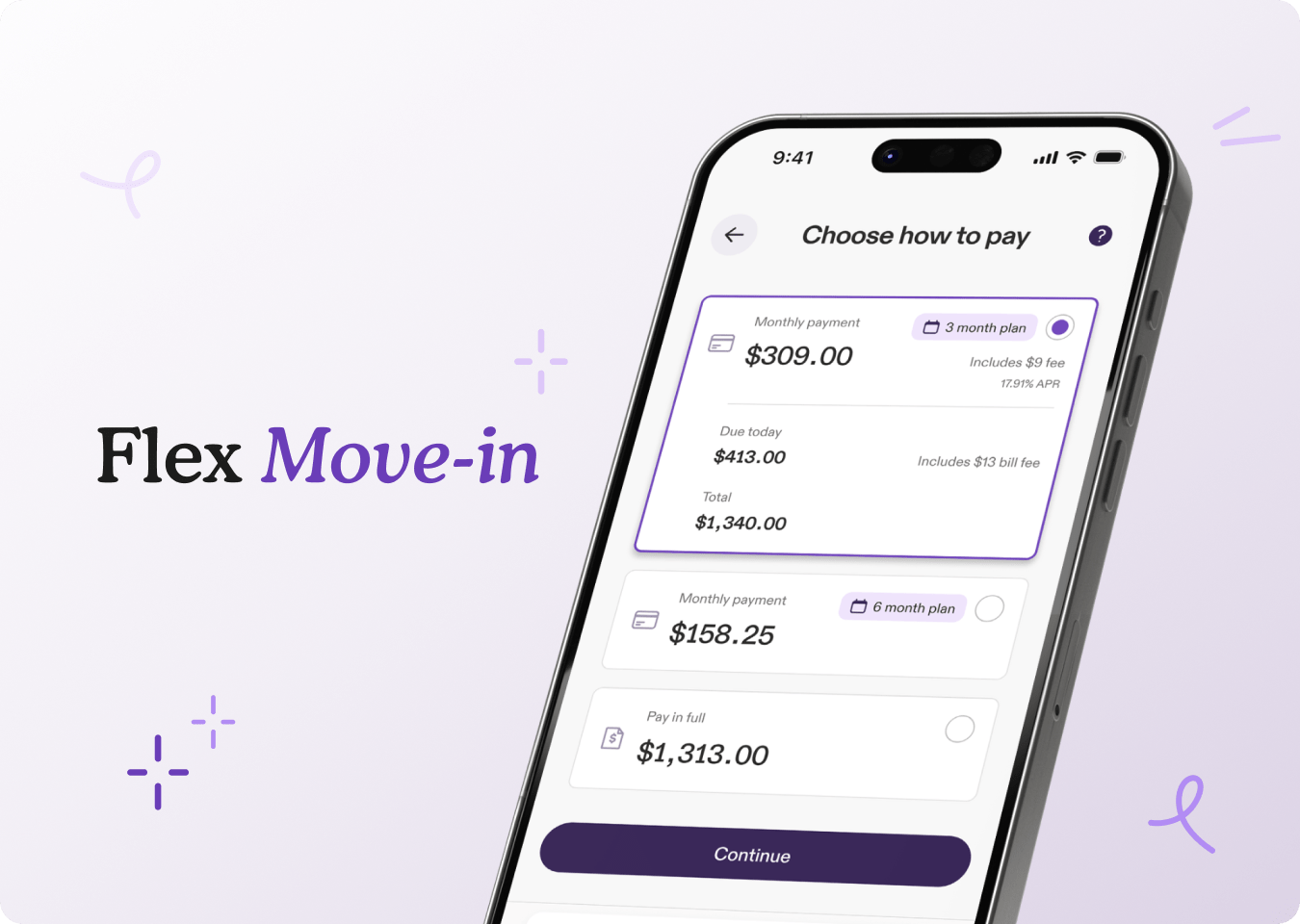Solving the two biggest pain points in leasing
When Flex launched Flex Rent in 2019, our mission was clear: give renters more breathing room and property managers more predictable cash flow. By letting residents split rent into smaller payments while helping properties receive on-time payments, we set a new standard for rent payments—one trusted by over 2,400 property management companies (PMCs) across more than 8 million units nationwide.
Today, Flex processes over $20B in rent payments and has supported more than 12M on-time payments. But rent is only part of the financial equation for renters and PMCs. The move-in process—often burdened by large upfront costs—remains one of the biggest barriers to leasing velocity, occupancy rates, and resident satisfaction.
That’s why we’re introducing Flex Move-in: the next step in charting a new path for how renters secure housing and how rent is paid—one that works better for residents and property managers alike.
We see an industry ready for a shift—away from rigid, outdated payment norms and toward a rental experience that’s more flexible, affordable, and sustainable. With Flex Move-in, we’re tackling the costly move-in process so properties can lease faster and residents can get into homes without the financial strain that’s become the norm.
The cost barrier slowing your lease-ups
Move-in costs can feel like a wall for renters. Nationwide, 91% of renters pay a security deposit, but only 42% get it fully returned. Add first (and sometimes last) month’s rent, plus fees, and the totals can be staggering: a 2023 StreetEasy study found the average upfront cost to lease a unit reached $10,454, up 29% from 2019.
For PMCs, those costs often slow leasing velocity, increase lease fall-off, and leave units sitting vacant longer—impacting NOI and portfolio performance.
How Flex Move-in Helps:
Qualified residents can split their full move-in costs (security deposit, first month’s rent, pet fees, and more) into 3- or 6-month installments. PMCs receive 100% of the move-in amount upfront via ACH, with no risk of reversal and no extra operational lift.
Benefits for property managers:
- Fill units faster by removing upfront cost barriers
- Reliable payments without disputes or repayment risk
- No extra lift thanks to seamless integration into existing leasing flows
Benefits for residents:
- Lower financial stress during a costly life transition
- Smaller, fixed monthly installments that make move-in more affordable
- Fast, mobile-first checkout—no office visits or paper checks
See how Flex Move-in can help you reduce vacancy and improve leasing speed—Learn More
A proven model for predictable payments
Every rental relationship is shaped by financial touchpoints—moments where money changes hands and both resident stability and property performance are on the line.
We started with the biggest recurring touchpoint in renting: monthly rent. By aligning payments with income, Flex Rent helped residents avoid strain while driving more consistent, on-time payments for PMCs.
Now, Flex Move-in addresses the other major touchpoint at the very start of the lease: move-in costs. Large, one-time expenses can delay leasing, drive fall-off, and keep units vacant longer. With Flex, residents can spread these costs over time while properties receive the full amount upfront.
The result:
- Faster unit fill times
- Predictable revenue streams
- Higher retention through an improved resident experience
Reducing vacancy starts at Move-In
The rental housing industry is under growing pressure. The national rental vacancy rate averaged 6.8% in 2024, with principal cities at 7.1%—the highest in seven years. The average time to fill a unit has grown from 25 days in 2022 to roughly 36 days today, costing properties more than $4,000 per vacant unit per year.
For residents, large upfront costs can delay move-ins or cause them to walk away entirely. Even after move-in, rigid payment schedules can create strain, leading to late rent, turnover, and instability.
Flexibility works. Properties offering flexible rent payments have experienced up to a 20% drop in vacancy losses and a 6% reduction in tenants with bad debt.* Residents pay on time more consistently, portfolios perform better, and relationships improve.
Flex Move-in applies the same model to the start of the rental journey—eliminating the upfront cost barrier while securing predictable revenue for PMCs and delivering a smoother, more equitable experience for residents.
Looking ahead: a more flexible future for renting
From the first payment a resident makes to the monthly rent that follows, financial friction has long shaped the rental experience. At Flex, we believe it doesn’t have to.
Our mission is to create more breathing room in people’s lives while giving PMCs the stability they need to grow. With Flex Rent, we redefined how residents pay rent. With Flex Move-in, we’re transforming how they begin their tenancy.
These solutions are part of a broader shift in the rental housing industry—moving beyond rigid, outdated payment norms toward a model where flexibility and predictability work together to benefit everyone. By expanding from a single offering to a suite of connected solutions, we’re laying the groundwork for a new standard in financial wellness for renters and a more resilient, profitable rental housing ecosystem for property managers.
We see a future where flexibility is the norm, not the exception—and Flex Move-in is just the next step toward making that future a reality.
Start removing financial barriers at move-in. See how Flex Move-in can help you lease faster, reduce vacancy, and improve resident satisfaction—Learn More
*Source: Flex internal data, 2024–2025. Analysis based on over 36,000 units for vacancy losses and over 8,000 units for bad debt reduction. Results may vary and do not constitute a guarantee of future performance.



